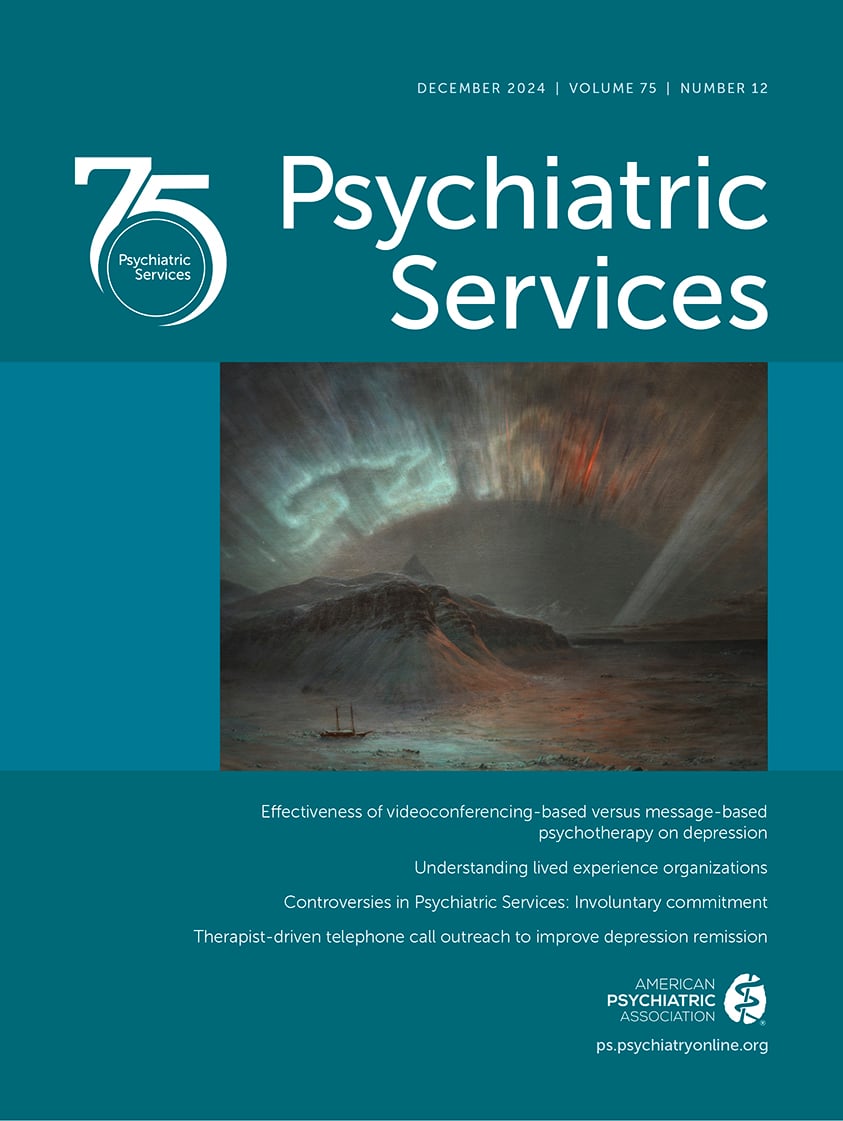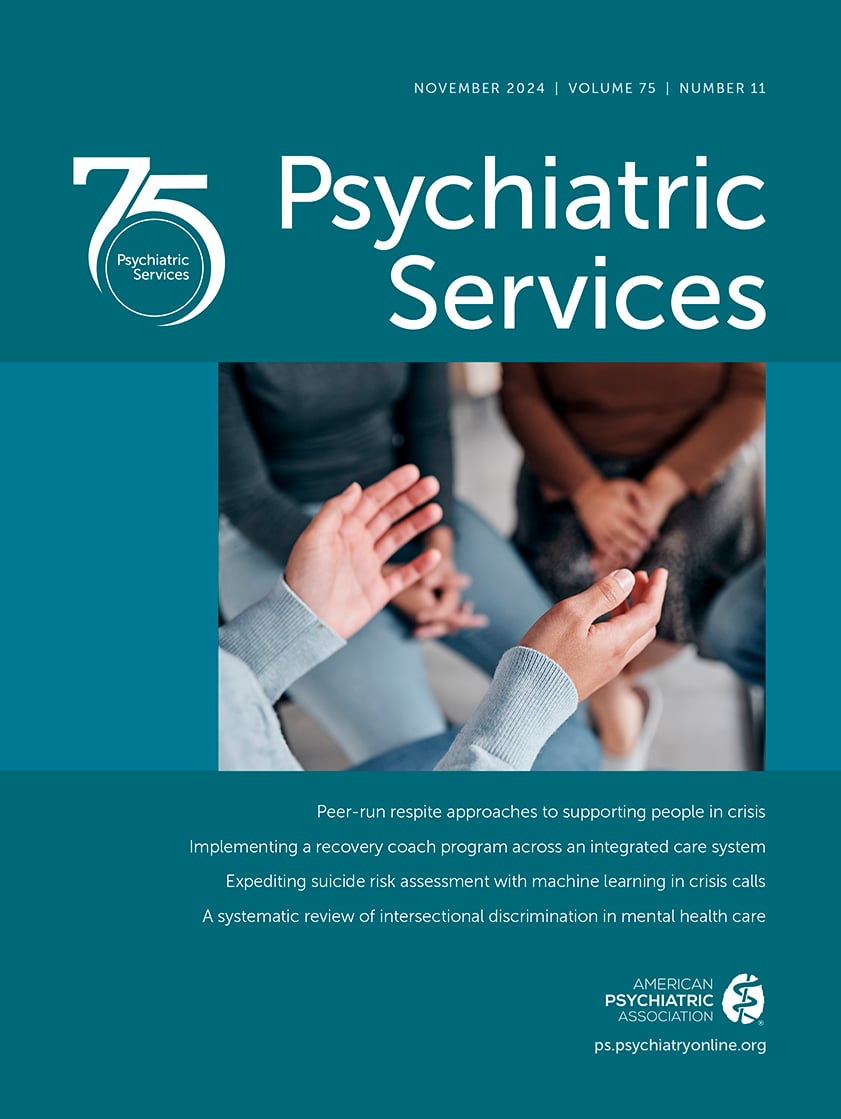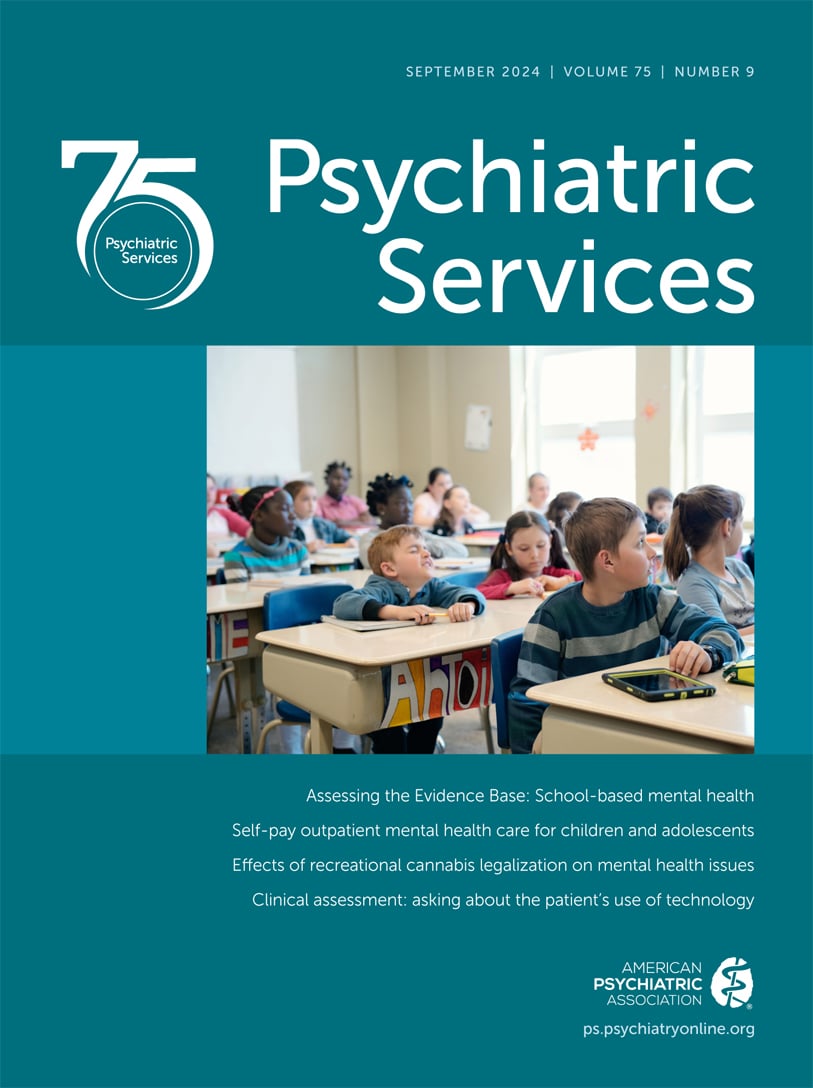Psychiatric Services
- Volume 67
- Number 3
- March 2016
This Month’s Highlights
Taking Issue
Articles
Publication date: 15 December 2015
Pages265–274Objective: Immigrants face stressors unique to the experience of migration that may exacerbate or cause mental health problems but access care at rates far below the general population, leaving them at risk of untreated mental health conditions. This ...
https://doi.org/10.1176/appi.ps.201500004Publication date: 01 December 2015
Pages275–281Objective: Housing First with assertive community treatment (ACT) is a promising approach to assist people with serious mental illness to exit homelessness. The article presents two-year findings from a multisite trial on the effectiveness of Housing First ...
https://doi.org/10.1176/appi.ps.201400587Publication date: 16 November 2015
Pages282–288Objective: This study used nationally representative household survey data to examine the association between mental illness and experiences with usual care providers and health plans among persons with public or private insurance (N=25,176). Methods: Data ...
https://doi.org/10.1176/appi.ps.201400514Publication date: 16 November 2015
Pages289–295Objective: This study examined national trends between 1999 and 2010 in not otherwise specified (NOS) DSM-IV psychiatric diagnoses and in related medication treatment patterns reported for adults during outpatient physician office visits. Methods: Data on ...
https://doi.org/10.1176/appi.ps.201500045Publication date: 02 November 2015
Pages296–301Objective: The authors examined secondary outcomes of STRIDE, a randomized controlled trial that tested a weight-loss and lifestyle intervention for individuals taking antipsychotic medications. Methods: Hierarchical linear regression was used to explore the ...
https://doi.org/10.1176/appi.ps.201400535Publication date: 16 November 2015
Pages302–309Objective: Prior research evaluated various effects of the 2004 black-box warning by the U.S. Food and Drug Administration (FDA) on the risk of suicidality among children associated with use of antidepressants, but the warning’s effect on dosing of ...
https://doi.org/10.1176/appi.ps.201500088Publication date: 02 November 2015
Pages310–315Objective: The goal of these analyses was to describe the 12-month prevalence of mental health services retention for youths ages six to 12 years and identify predictors of treatment retention. Data were from the Longitudinal Assessment of Manic Symptoms ...
https://doi.org/10.1176/appi.ps.201400553Publication date: 04 January 2016
Pages316–323Objective: Little is known about utilization rates of the various depression treatment options available in the private sector for children and adolescents. For privately insured youths, this study examined the utilization frequency of six treatment ...
https://doi.org/10.1176/appi.ps.201500090Publication date: 01 December 2015
Pages324–331Objectives: This study identified patient-, hospital-, and community-level factors associated with timely follow-up care following psychiatric hospitalization for children and adolescents with mood disorders. Methods: The patients were 7,826 youths (ages six ...
https://doi.org/10.1176/appi.ps.201500104Publication date: 04 January 2016
Pages332–338Objective: Psychiatric hospitalization is essential in the clinical management of suicidal adolescents, and a considerable number of hospitalized adolescents are rehospitalized, yet little is known about how this experience may influence postdischarge ...
https://doi.org/10.1176/appi.ps.201400252Brief Reports
Publication date: 15 December 2015
Pages342–345Objective: This study assessed the relationship between nonadherence to psychotropic and nonpsychotropic medications for 88 patients nonadherent to medication treatment for bipolar disorder. Methods: This descriptive study was part of a clinical trial ...
https://doi.org/10.1176/appi.ps.201500010Publication date: 15 December 2015
Pages346–349Objective: The objective of this study was to describe the work and experiences of psychiatrists practicing integrated care in the community. Methods: Consulting psychiatrists working in integrated care participated in an online survey about their ...
https://doi.org/10.1176/appi.ps.201400592Publication date: 02 November 2015
Pages350–353Objective: Low mental health literacy (MHL) is widespread in the general population and even more so among racial and ethnic minority groups. Mental Health First Aid (MHFA) aims to improve MHL. The objective of this study was to determine the impact of ...
https://doi.org/10.1176/appi.ps.201400375Publication date: 02 November 2015
Pages354–357Objective: This study explored predisposing, illness-related, and enabling factors as predictors of mental health service use among disaster survivors with perceived need for services. Methods: Participants (N=658) were part of a three-wave, population-based ...
https://doi.org/10.1176/appi.ps.201500027Open Forum
Publication date: 04 January 2016
Pages339–341Antipsychotic medications, especially second-generation antipsychotics, have increasingly been prescribed to children under age 18 in the United States. They are approved to treat pediatric bipolar and psychotic disorders and aggressive behaviors among ...
https://doi.org/10.1176/appi.ps.201500272Datapoints
Best Practices
Publication date: 16 November 2015
Pages259–261The period of transition from hospital to community services is critical for individuals with serious mental illness. The American Association of Community Psychiatry developed guidelines for transitional services in behavioral health care. This column ...
https://doi.org/10.1176/appi.ps.201500435Research & Services Partnerships
Publication date: 15 December 2015
Pages262–264This column describes the conceptualization and implementation of an innovative collaboration between Oregon State Hospital and Oregon Health and Science University that was created to address understaffing and improve the quality of care. The hospital ...
https://doi.org/10.1176/appi.ps.201500467Letters
News & Notes
Past Issues
View Issues Archive
Vol. 75 | No. 12

Vol. 75 | No. 11

Vol. 75 | No. 10
